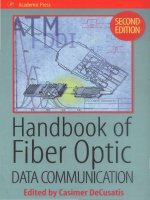fluid catalytic cracking handbook - 2nd ed
Bạn đang xem bản rút gọn của tài liệu. Xem và tải ngay bản đầy đủ của tài liệu tại đây (15.11 MB, 384 trang )
Cracking
SECOND
EDITION
Fluid
Catalytic
Handbook
This page intentionally left blank
Fluid
Catalytic
Handbook
Design,
Operation
and
Troubleshooting
of
FCC
Facilities
SECOND
EDITION
GP
Gulf
Professional Publishing
I'M
an
imprint
of
Butterworth-Heinemann
Cracking
Handbook
Fluid
Catalytic
Cracking
Handbook
Design,
Operation,
and
Troubleshooting
of
FCC
Facilities
SECOND
EDITION
Copyright
©
2000
by
Butterworth-Heinemann.
All rights
reserved. Printed
in the
United
States
of
America.
This
book,
or
parts thereof,
may not be
reproduced
in any
form without
permission
of the
publisher.
Originally
published
by
Gulf Publishing Company,
Houston.
TX.
For
information, please contact:
Manager
of
Special Sales
Butterworth-Heinemann
225
Wildwood Avenue
Wobum,MA01801–2041
Tel:
781-904-2500
Fax:781-904-2620
For
information
on all
Butterworth-Heinemann publications
available,
contact
our
World Wide
Web
home page
at:
10
9 8 7 6 5 4 3 2
Library
of
Congress
Cataloging-in-Publication Data
Sadeghbeigi, Reza.
Fluid
catalytic cracking handbook
/
Reza
Sadeghbeigi.—2nd
ed.
p.
cm.
Includes
bibliographical references
and
index.
ISBN
0-88415-289-8
(alk.
paper)
1.
Catalytic cracking.
1.
Title.
TP690.4.S23
2000
665.533
dc2l
00-035361
Printed
in the
United
States
of
America.
Printed
on
acid-free
paper
(°°).
This
book
is
dedicated
to
our
respected clients
who
have
contributed
to the
success
of RMS
Engineering, Inc.
and to the
content
of
this book
This page intentionally left blank
Acknowledgments
xi
Preface
to the
Second Edition
xii
CHAPTER
1
Process Description
1
Feed
Preheat,
6.
Riser—Reactor—Stripper,
7,
Regenerator-
Heat/Catalyst Recovery,
13.
Main Fractionator,
22. Gas
Plant,
25.
Treating Facilities,
31.
Summary,
39.
References,
39.
FCC
Feed Characterization
40
Hydrocarbon Classification,
41.
Feedstock
Physical Properties,
45.
Impurities,
54.
Empirical Correlations,
68.
Benefits
of
Hydroprocessing,
81.
Summary,
82.
References,
82.
CHAPTER
3
FCC
Catalysts
84
Catalyst Components,
84.
Catalyst Manufacturing
Techniques,
96.
Fresh Catalyst Properties,
99.
Equilibrium
Catalyst Analysis, 102. Catalyst Management, 109.
Catalyst Evaluation. 115. Additives, 117. Summary, 123.
References,
124.
CHAPTER
4
Chemistry
of FCC
Reactions
125
Thermal Cracking, 126. Catalytic Cracking, 128. Thermo-
dynamic
Aspects, 136. Summary, 136. References,
138
References,
134.
Contents
CHAPTER
5
Unit Monitoring
and
Control
_ _
139
Material
Balance, 140.
Heat
Balance, 158. Pressure
Balance,
166.
Process
Control Instrumentation, 177.
Summary,
180. References, 181.
CHAPTER
6
Products
and
Economics
182
FCC
Products, 182.
FCC
Economics, 202. Summary, 205.
References,
205.
CHAPTER
7
Project
Management
and
Hardware Design
206
Project
Management Aspects
of an FCC
Revamp, 206.
Process
and
Mechanical Design Guidelines, 212.
Summary,
232. References, 232.
CHAPTER
8
Troubleshooting
234
Guidelines
for
Effective
Troubleshooting, 235. Catalyst
Circulation,
236. Catalyst
Losses,
244. Coking/Fouling, 248.
Flow
Reversal, 251. High
Regenerator
Temperature, 256.
Increase
in
Afterburn, 259. Hydrogen Blistering, 260.
Hot
Gas
Expanders, 263. Product Quantity
and
Quality, 264.
Summary,
275.
CHAPTER
9
Debottlenecking
and
Optimization
276
Introduction,
276. Approach
to
Debottlenecking, 277.
Reactor/Regenerator Structure, 281. Flue
Gas
System, 296.
FCC
Catalyst, 296. Instrumentation, 304. Utilities/Offsites,
305. Summary, 306.
Emerging Trends
in
Fluidized Catalytic Cracking
_ 307
Reformulated
Fuels, 308. Residual Fluidized Catalytic
Cracking
(RFCC), 323. Reducing
FCC
Emissions, 327.
Emerging
Developments
in
Catalysts,
Processes,
and
Hardware,
232. Summary, 335. References, 336.
APPENDIX
1
Temperature Variation
of
Liquid Viscosity
338
APPENDIX
2
Correction
to
Volumetric Average Boiling Point
339
APPENDIX
3
TOTAL
Correlations
340
APPENDIX
4
n-d-M Correlations
_ _._
._ _
__._
_ 341
APPENDIX
5
Estimation
of
Molecular
Weight
of
Petroleum Oils from Viscosity Measurements
342
APPENDIX
6
Kinematic
Viscosity
to
Saybolt
Universal Viscosity
_._ _ 344
APPENDIX
7
API
Correlations
345
APPENDIX
8
Definitions
of
Fluidization
Terms
_._ _ _
_ 347
Conversion
of
ASTM
50%
Point
to
TBP 50%
Point
Temperature
_ 350
APPENDIX
10
Determination
of TBP Cut
Points from ASTM D-86
351
APPENDIX
11
Nominal
Pipe Sizes __._
_ 353
Conversion Factors
__ _
_
355
Glossary
_.
357
Index
_._
_ 363
About
the
Author __
_ ._
.__.
369
Acknowledgments
I
am
grateful
to the
following individuals
who
played
key
roles
in
this
book's
completion: Warren Letzsch
of
Stone
&
Webster Engineer-
ing
Corporation; Terry Reid
of
Akzo Nobel Chemicals, Inc.; Herb
Telidetzki
of KBC
Advanced
Technologies,
Inc.;
and
Jack
Olesen
of
Grace/Davison provided valuable input.
My
colleagues
at RMS
Engineering, especially Shari Gauldin, Larry Gammon,
and
Walt Broad
went
the
"extra mile"
to
ensure
the
book's accuracy
and
usefulness.
Preface
to the
The
first
edition
of
this book
was
published nearly
five
years ago.
The
book
was
well received
and the
positive reviews were over-
whelming.
My
main objective
of
writing this second edition
is to
provide
a
practical "transfer
of
experience"
to the
readers
of the
knowledge that
I
have gained
in
more than
20
years
of
dealing
with
various
aspects
of the cat
cracking
process.
This second edition
fulfills
my
goal
of
discussing issues related
to
the
FCC
process
and
provides practical
and
proven recommendations
to
improve
the
performance
and
reliability
of the
FCCU operations.
The new
chapter (Chapter
9)
offers
several
"no-to-low"
cost modifica-
tions
that, once implemented.,
will
allow debottlenecking
and
optimiza-
tion
of the cat
cracker.
I
am
proud
of
this second edition.
For
one,
I
received input/feedback
from
our
valued clients, industry "FCC gurus,"
as
well
as my
colleagues
at
RMS
Engineering, Inc. Each chapter
was
reviewed carefully
for
accuracy
and
completeness.
In
several
areas,
I
have provided additional
discussions
to
cover
different
FCCU configurations
and
finally,
both
the
metric
and
English
units
have been used
to
make
it
easier
for
readers
who use the
metric system.
Unfortunately,
the
future
of
developing
new
technologies
for
petro-
leum
refining
in
general,
and cat
cracking
in
particular,
is not
promis-
ing.
The
large, multinational
oil
companies have just about abandoned
their
refining
R&D
programs.
The
refining
industry
is
shrinking
rapidly.
There
is no
"farm system"
to
replace
the
current crop
of
technology
experts.
In cat
cracking,
we
begin
to see
convergence
and
similarity
in the
number
of
offered technologies. Even
the FCC
catalyst
suppliers
and
technology licensers have been relatively
quiet
in
developing "breakthrough" technologies since
the
introduction
of
Second Edition
zeolite
in the
late
1960s.
More
and
more
companies
are
outsourcing
their
technical needs.
In the
next several years, refiners
will
be
spending
much
of
their capital
to
reduce
sulfur
in
gasoline
and
diesel,
In
the
area
of cat
cracking,
the
emphasis will
be on
improving
the
performance
and
reliability
of
existing units,
as
well
as
"squeezing"
more
feed
rate and/or conversion without capital expenditure.
In
light
of
these developments, this book
is
needed more than
ever.
Reza
Houston,
Texas
This page intentionally left blank
CHAPTER
Process Description
Fluid
catalytic cracking (FCC) continues
to
play
a key
role
in an
integrated
refinery
as the
primary conversion
process.
For
many
refiners,
the cat
cracker
is the key to
profitability
in
that
the
successful
operation
of the
unit determines whether
or not the
refiner
can
remain
competitive
in
today's
market.
Approximately
350 cat
crackers
are
operating worldwide, with
a
total processing capacity
of
over 12.7 million barrels
per day
[1]. Most
of
the
existing
FCC
units have been designed
or
modified
by six
major
technology
licensers:
1.
ABB
Lummus Global
2.
Exxon Research
and
Engineering (ER&E)
3.
Kellogg Brown
&
Root—KBR (formerly
The
M.W. Kellogg
Company)
4.
Shell
Oil
Company
5.
Stone
&
Webster Engineering Corporation (SWEC)/IFP
6. UOP
(Universal
Oil
Products)
Figures
1-1
through
1-3
contain sketches
of
typical
unit
configura-
tions offered
by
some licensers. Although
the
mechanical configuration
of
individual
FCC
units
may
differ, their common objective
is to
upgrade low-value feedstock
to
more valuable products. Worldwide,
about
45% of all
gasoline comes from
FCC and
ancillary units, such
as the
alkylation unit.
Since
the
start-up
of the
first
commercial
FCC
unit
in
1942, many
improvements have been made.
These
improvements have enhanced
the
unit's mechanical reliability
and its
ability
to
crack heavier, lower-
value
feedstocks.
The FCC has a
remarkable history
of
adapting
to
continual
changes
in
market demands. Table
1-1
shows major develop-
ments
in the
history
of the
process.
The FCC
unit
uses
a
microspheroidal catalyst, which behaves like
a
liquid
when properly aerated
by
gas.
The
main purpose
of the
unit
Fluid
Catalytic Cracking
Handbook
Regen
Flue
Gas
Products
Transfer
Line
Reactor
Air
Blower
Figure
1-1. Typical schematic
of
Exxon's
flexicracker,
is
to
convert high-boiling petroleum fractions called
gas oil to
high-
value, high-octane gasoline
and
heating oil.
Gas oil is the
portion
of
crude
oil
that commonly boils
in the
650+°F
to
1,050+°F (330°
to
550°C) range. Feedstock properties
are
discussed
in
Chapter
2.
Before
proceeding,
it is
helpful
to
examine
how a
typical
cat
cracker
fits
into
the
refinery process.
A
petroleum refinery
is
composed
of
several
processing units that convert
raw
crude
oil
into usable products
such
as
gasoline, diesel,
and jet
fuel
(Figure 1-4).
The
crude unit
is the
first
unit
in the
refining process. Here,
the
raw
crude
is
distilled into several intermediate products: naphtha,
kerosene, diesel,
and gas
oil.
The
heaviest portion
of the
crude oil,
(text
continued
on
page
6)
Flue
Gas
Process
Description
To
Fractionator
Reactor
^Stripping
Steam
Figure
1-2.
UOP FCC
(courtesy
of
UOP).
Second stage
regenerator
Combustion
Air
First stage
regenerator
Combustion
Air
Lift
air
Riser
termination
device
r
Feed Injection
Figure
1-3. SWEC
stacked
FCC
unit
(courtesy
of
Stone
&
Webster Engi-
neering Corporation),
Fluid
Catalytic Cracking Handbook
Table
1-1
The
Evolution
of FCC
1915
McAfee
of
Gulf Refining
Co.
discovered that
a
Friedel-Crafts
aluminum
chloride catalyst could catalytically crack heavy oil.
1936
Use of
natural clays
as
catalyst greatly improved cracking
efficiency.
1938 Catalyst Research Associates (CRA)
was
formed.
The
original
CRA
members
were:
Standard
of New
Jersey (Exxon), Stan-
dard
of
Indiana (Amoco), Anglo Iranian
Oil
Company
(BP
Oil),
The
Texas Company (Texaco), Royal Dutch Shell,
Universal
Oil
Products (UOP),
The
M.W, Kellogg Company,
and
I.G. Farben (dropped
in
1940).
1942
First commercial
FCC
unit
(Model
I
upflow
design) started
up
at
Standard
of New
Jersey's Baton Rouge, Louisiana,
refinery.
1943 First down-flow design
FCC
unit
was
brought on-line. First
thermal catalytic cracking (TCC) brought on-line.
1947
First
UOP
stacked
FCC
unit
was
built. Kellogg introduced
the
Model
III FCC
unit.
1948 Davison Division
of
W.R. Grace
& Co.
developed micro-
spheroidal
FCC
catalyst.
1950s Evolution
of
bed-cracking process designs.
1951 M.W. Kellogg introduced
the
Orthoflow design.
1952 Exxon
introduced
the
Model
IV.
1954 High alumina (A1
2
O
2
)
catalysts were introduced.
Mid-50s
UOP
introduces side-by-side design.
1956 Shell invented
riser
cracking.
1961 Kellogg
and
Phillips developed
and put the
first
resid cracker
onstream
at
Borger, Texas.
1964 Mobil
Oil
developed
USY and ReY FCC
catalyst. Last
TCC
unit
completed.
1972 Amoco
Oil
invented high-temperature regeneration.
1974 Mobil
Oil
introduced
CO
promoter.
1975
Phillips Petroleum developed antimony
for
nickel passivation.
1981 TOTAL invented two-stage regeneration
for
processing residue,
1983 Mobil reported
first
commercial
use of
ZSM-5 octane/olefins
additive
in FCC
1985 Mobil started installing closed cyclone systems
in its FCC
units.
1994
Coastal
Corporation
conducted commercial test
of
ultrashort
residence time, selective cracking.
1996
ABB
Lummus Global acquired Texaco
FCC
technologies.
TAR
f
•XL
I
!j
§
DELAYED
COKER
3AS(
gasoline to
REFORMER
DECANT
OIL
GASOLINE
HEATING
OIL
NO.
6 OIL
Figure
1-4.
A
typical high conversion refinery.
6
Fluid Catalytic Cracking Handbook
(text
continued from page
2)
which
cannot
be
distilled
in the
atmospheric tower,
is
heated
and
sent
to the
vacuum
tower where
it is
split into
gas oil and
tar.
The tar
from
the
vacuum
tower
is
sent
to be
further
processed
in a
delayed coker,
deasphalting unit,
or
visbreaker,
or is
sold
as
fuel
oil or
road asphalt.
The gas oil
feed
for the
conventional
cat
cracker comes primarily
from
the
atmospheric column,
the
vacuum
tower,
and the
delayed
coker.
In
addition,
a
number
of
refiners blend some atmospheric
or
vacuum
resid into
the
feedstocks
to be
processed
in the FCC
unit.
The FCC
process
is
very complex.
For
clarity,
the
process descrip-
tion
has
been broken down into
six
separate sections:
•
Feed Preheat
•
Riser—Reactor—Stripper
«
Regenerator—Heat/Catalyst Recovery
•
Main
Fractionator
• Gas
Plant
«
Treating Facilities
FEED
PREHEAT
Most refineries produce
sufficient
gas oil to
meet
the cat
crackers'
demand. However,
in
those refineries
in
which
the gas oil
produced
does
not
meet
the cat
cracker capacity,
it may be
economical
to
supplement feed
by
purchasing
FCC
feedstocks
or
blending some
residue.
The
refinery-produced
gas oil and any
supplemental
FCC
feedstocks
are
generally combined
and
sent
to a
surge dram, which
provides
a
steady
flow of
feed
to the
charge pumps. This drum
can
also separate
any
water
or
vapor that
may be in the
feedstocks.
From
the
surge drum,
the
feed
is
normally heated
to a
temperature
of
500°F
to
700°F
(260°C
to
370°C).
The
main fractionator bottoms
pumparound and/or fired heaters
are the
usual
sources
of
heat.
The
feed
is
first
routed through heat exchangers using
hot
streams
from
the
main fractionator.
The
main fractionator
top
pumparound, light
cycle
oil
product,
and
bottoms pumparound
are
commonly used (Fig-
ure
1-5). Removing heat
from
the
main fractionator
is at
least
as
important
as
preheating
the
feed.
Most
FCC
units
use
fired
heaters
for FCC
feed
final
preheat.
The
feed
preheater provides control over
the
catalyst-to-oil ratio,
a key
variable
in the
process.
In
units where
the air
blower
is
constrained.
Process
Description
Vent
to
Main Column
-cSi—^
Slurry
I
Feed
Preheater
Figure
1-5.
Typical
feed preheat system.
increasing preheat temperature allows increased throughput.
The
effects
of
feed
preheat
are
discussed
in
Chapter
6.
RISER—REACTOR—STRIPPER
The
reactor-regenerator
is the
heart
of the FCC
process.
In a
modern
cat
cracker, virtually
all the
reactions occur
in 1.5 to 3.0
seconds
before
the
catalyst
and the
products
are
separated
in the
reactor.
From
the
preheater,
the
feed enters
the
riser
near
the
base where
it
contacts
the
regenerated catalyst
(see
Figure
1-6).
The
ratio
of
catalyst-
to-oil
is
normally
in the
range
of 4:1 to 9:1 by
weight.
The
heat
absorbed
by the
catalyst
in the
regenerator provides
the
energy
to
heat
the
feed
to its
desired reactor temperature.
The
heat
of the
reaction
occurring
in the riser is
endothermic (i.e.,
it
requires energy input).
The
circulating catalyst provides this energy.
The
typical regenerated catalyst
temperature
ranges between 1,250°F
to
1,350°F (677°C
to
732°C).
8
Fluid Catalytic Cracking Handbook
To
Reactor
or
Cyclone
Catalyst
From
Regenerator
(Typical
for
Multiple
Nozzles)
Figure
1-6.
Typical
riser "Y".
The
catalytic reactions occur
in the
vapor phase. Cracking reactions
begin
as
soon
as the
feed
is
vaporized.
The
expanding volume
of the
vapors that
are
generated
are the
main driving force
to
carry
the
catalyst
up the
riser.
Catalyst
and
products
are
quickly separated
in the
reactor. However,
some thermal
and
non-selective catalytic reactions continue.
A
number
Process Description
9
of
refineries
are
modifying
the
riser termination devices
to
minimize
these
reactions.
The
riser is a
vertical
pipe.
It
usually
has s 4- to
5-inch
(10 to 13
cm)
thick refractory lining
for
insulation
and
abrasion resistance.
Typical risers
are 2 to 6
feet
(60 to 180 cm) in
diameter
and 75 to
120
feet
(25 to 30
meters) long.
The
ideal riser simulates
a
plug
flow
reactor, where
the
catalyst
and the
vapor travel
the
length
of the riser
with
minimum back mixing.
Efficient
contacting
of the
feed
and
catalyst
is
critical
for
achieving
the
desired
cracking
reactions. Steam
is
commonly used
to
atomize
the
feed. Smaller
oil
droplets increase
the
availability
of
feed
at the
reactive acid sites
on the
catalyst. With high-activity zeolite catalyst,
virtually
all of the
cracking reactions take place
in
three seconds
or
less.
Risers
are
normally designed
for an
outlet vapor velocity
of 50
ft/sec
to
75
ft/sec
(15.2
to
22.8 m/sec).
The
average hydrocarbon residence
time
is
about
two
seconds (based
on
outlet conditions).
As a
consequence
of
the
cracking
reactions,
a
hydrogen-deficient material called coke
is
deposited
on the
catalyst, reducing catalyst activity.
Catalyst
Separation
After
exiting
the
riser, catalyst enters
the
reactor vessel.
In
today's
FCC
operations,
the
reactor serves
as a
housing
for the
cyclones.
In
the
early application
of
FCC,
the
reactor vessel provided further
bed
cracking,
as
well
as
being
a
device used
for
additional catalyst separation.
Nearly every
FCC
unit employs some type
of
inertial separation
device connected
on the end of the
riser
to
separate
the
bulk
of the
catalyst
from
the
vapors.
A
number
of
units
use a
deflector device
to
turn
the
catalyst direction downward.
On
some units,
the riser is
directly attached
to a set of
cyclones.
The
term "rough cut" cyclones
generally refers
to
this type
of
arrangement.
These
schemes separate
approximately
75% to 99% of the
catalyst
from
product vapors.
Most
FCC
units employ either single
or
two-stage cyclones (Figure
1-7)
to
separate
the
remaining
catalyst
particles
from
the
cracked
vapors.
The
cyclones collect
and
return
the
catalyst
to the
stripper
through
the
diplegs
and flapper/trickle
valves (See Figure 1-8).
The
product
vapors exit
the
cyclones
and flow to the
main fractionator
for
recovery.
The
efficiency
of a
typical two-stage cyclone system
is
99.995+%.
10
Fluid Catalytic Cracking Handbook
Figure
1-7.
A
two-stage cyclone system. (Courtesy
of
Bill Dougherty,
BP Oil
Refinery,
Marcus Hook, Pa.)
It
is
important
to
separate catalyst
and
vapors
as
soon
as
they
enter
the
reactor. Otherwise,
the
extended contact time
of the
vapors
with
the
catalyst
in the
reactor housing will allow
for
non-selective catalytic
recracking
of
some
of the
desirable products.
The
extended residence
time also promotes thermal cracking
of the
desirable products.









